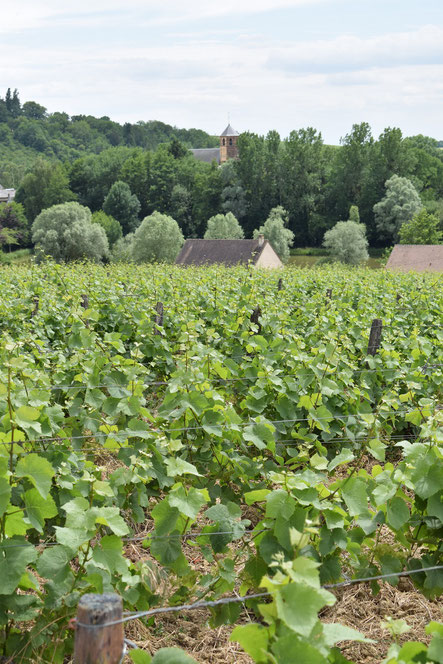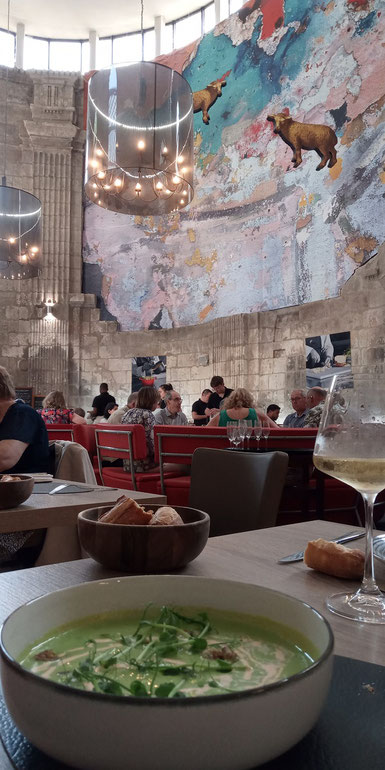Wine tourism in the Cher department
AOC Sancerre and Menetou-Salon

Sancerre is undoubtedly the region's flagship AOC. Ask foreign wine lovers if they are familiar with this AOC and the answer will undoubtedly be positive. This is probably because 60% of
Sancerre's production is now exported. Covering more than 3,000 hectares, this AOC mainly produces still white wines made from Sauvignon Blanc, but red wine production has been increasing
recently, with wines made from Pinot Noir that, when aged in barrels, sometimes rival their Burgundy neighbours. Rosé wines, made from Pinot Noir as well, represent only a small percentage of the
production. The clay and flint soils and those made of marl and fossilized oysters allow the production of wines with high acidity, often very mineral. On the other hand, "caillottes" (the local
name for limestone stones) give less full-bodied and rounder wines. A wide variety of wines awaits you in this AOC, which you can discover at the "Maison des Vins" located in the village of
Sancerre. Don't forget to taste the local white wines with the famous Crottin de Chavignol, an AOC goat cheese produced in the village located opposite the Sancerre hill (pictured in the banner
of this webpage).
Could Menetou-Salon be called "Sancerre's little sister"? Actually this AOC, whose reputation is growing, has nothing to be ashamed of. It features the same soil as those in Chablis and the Aube
(part of the Champagne area of production) regions: the famous Kimmeridigean marls allows for the production of mineral wines with high acidity. All three colors of wine are produced by AOC
Menetou-Salon, with Sauvignon Blanc for the white wines and Pinot Noir for the reds and rosés. If you happen to be the village of Menetou-Salon at lunch or dinner time, you should stop at "C'heu
l'Zib": this restaurant, which has been run by the same family for several generations, hasn't changed much for many decades. It serves hearty regional food, paired with Menetou-Salon wines
presented on an endless wine list! This is definitely a meal you'll remember!
AOC Reuilly and Quincy

Reuilly is the only AOC in the department that produces all three colors of wine. The vineyard is planted in six villages, both in the Cher and Indre departments, and covers approximately 300
hectares. The white wines are made with Sauvignon Blanc, the reds with Pinot Noir. Pinot Gris is one of the grape varieties allowed for the production of dry rosé wines. If you want to taste a
local rosé, I recommend you try "Les Chatillons" from Domaine de Reuilly (formerly owned by winemaker Denis Jamain), it's amazing! Have it blind tasted, your guests will for sure think it is a
white wine. For red wines, Baptiste Pointereau of Domaine de la Pagerie produces highly concentrated and fruity wines, ranging from light-bodied and easy-drinking wines (e.g. "Les Terres de
Silice", to be enjoyed as an aperitif, with soft cheese or grilled meat in summer) to medium-bodied terroir-driven wines (e.g. "Les Belles Terres"). Luc Tabordet's red Reuilly is a light-bodied
and crisp wine, with extremely fruity aromas. It amazes Pinot Noir lovers. I had this wine tasted in black glasses during a festive event and I surprised the guests who were not really sure about
the colour of the wine that was in their glasses!
Quincy was the first wine AOC created in the Loire Valley in 1936. Just under 350 hectares are planted in two villages. This AOC exclusively produces dry white wines made from Sauvignon Blanc. If
you were to taste only one wine, I recommend "Les grandes vignes de Villavin" produced by the Mardon & Tabordet estate: this wine is aged in jars, which gives it high acidity but also fat and
roundness, as well as intense fruity and mineral aromas. I had the 2021 vintage tasted during a wine course in spring 2025, all the participants loved it.
AOC Chateaumeillant
Like Reuilly, AOC Chateaumeillant is located astride the Cher and Indre departments. It is the smallest of all 5 AOCs, with 70 hectares planted with Gamay Noir à jus blanc and Pinot Noir to produce red wines, and less than 5 hectares of Pinot Gris for the production of rosé wines. Blends are mandatory. This rare AOC is now looked for by wine lovers. I recommend tasting the wines of Domaine Lecomte, which is located in AOC Quincy but grows 3 hectares of vineyard in Chateaumeillant. Their red Châteaumeillant 2019 surprised the members of a wine club to whom I had it tasted in 2023. If you drive through the village of Chateaumeillant, the restaurant "La Goutte Noire" will allow you to taste some local wines served with local products prepared simply but elegantly presented.
What to visit in the Cher department?
Bourges, its cathedral, its light and sound show and its marshes

Bourges is the perfect city to spend a weekend: it's neither too big nor too small and it allows visitors to explore its historical monuments in the city center and its surrounding marshes in
just two days.
Among Bourges' remarkable monuments is Saint Étienne's Cathedral, which has been listed as a UNESCO World Heritage Site since 1992. Its size and volume, both outside and inside, are impressive,
and its majestic doors are adorned with numerous beautiful sculptures. The tourist office offers guided tours of the city and cathedral, as well as a tour dedicated to the cathedral's
stained-glass windows. The oldest ones are full of details that tell stories that the common people will struggle to understand on their own. In any case, if you visit Bourges on a very warm day,
as I did, this old monument will be a much-needed shelter.
In the evening, the "Nuits Lumières" offer a unique way to discover the city. Bourges is home to the very first light and sound walking tour in France that showcases the city center with
spotlights enhancing the main monuments and allowing visitors to discover their history. You'll undoubtedly appreciate the town hall and the Jacques Cœur Palace in a different and new way after
walking through the city streets at night, guided by blue lampposts that will take you from one monument to another. A special, almost mystical atmosphere reigns in the cobbled streets of the
town.
Finally, don't miss the Bourges marshes, only a stone's throw from the city center. This incredible natural area is made up of canals and small islands, most of which are only accessible by boat.
A hiking trail, however, allows passerbys to enjoy the peaceful atmosphere. Park near one of the site's entrances and stroll leisurely, admiring the green environment and listening to the many
birds. There are cafés and restaurants along the way where you can enjoy a meal if you'd like to spend several hours in the area. This is a truly unique, genuine and rejuvenating site.
Finally, if you want to eat in Bourges, I recommend the restaurant Les Petits Plats du Bourbon for its setting: it is located in a former church! The food is mostly prepared with local and
seasonal produce and the wine list offers a selection of local wines as well as wines from other French wine-making regions.
The gardens of prieuré d'Orsan and the gardens of Ainay-le-Vieil castle
If you like gardens, beautiful homes and castles, here are some must-see places in the Cher department.
"Prieuré d'Orsan" is located in the village of Maisonnais, south of Bourges (a 55-minutes' drive from the city). It was founded in the 12th century and belonged to the famous Abbey of Fontevraud.
Nuns lived there until the French Revolution. The "Remarkable Gardens" were re-designed and re-created in 1994 and are absolutely amazing. You can wander through various spaces: a vegetable
garden, an orchard, a cloister with hornbeams, a rose garden, flowerbeds... And there is even a vineyard! Not surprising for a place once inhabited by religious people, who consumed wine daily,
during meals and mass.
Château d'Ainay-le-Vieil, which has been owned by the same family since the 15th century and was restored in 2023, combines medieval, Gothic and Renaissance architectures. The inside can be
visited with a guide. However, you can wander on your own through the gardens, where water is everywhere - moats, canals and water mirrors. A rose garden planted with old varieties faces two
magnificent Renaissance pavilions. To my mind, the "chartreuses" represent the highlight of the visit. They are walled gardens, communicating with one another by means of arcades. Each of them
has a theme: the flower garden, the sculpted orchard, the meditation garden, the cloister of simples, and the embroidery beds. Each "chartreuse' is a little world in itself, where it feels nice
to linger, smell flowers, sit and contemplate the landscape formed by trees, flowers and plants. I visited these gardens when the weather was a bit overcast and rainy but the place still looked
extremely beautiful.
Noirlac Abbey






